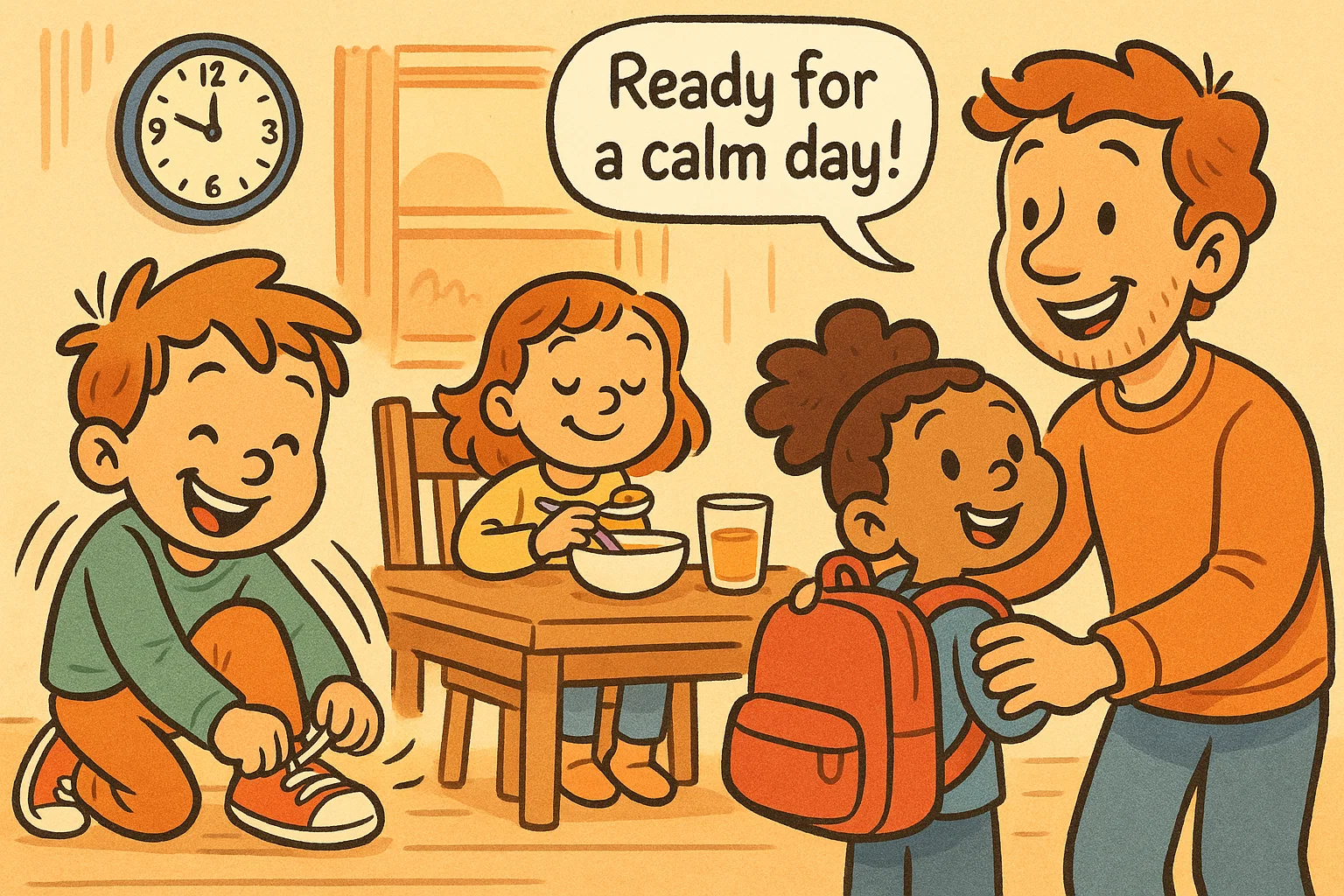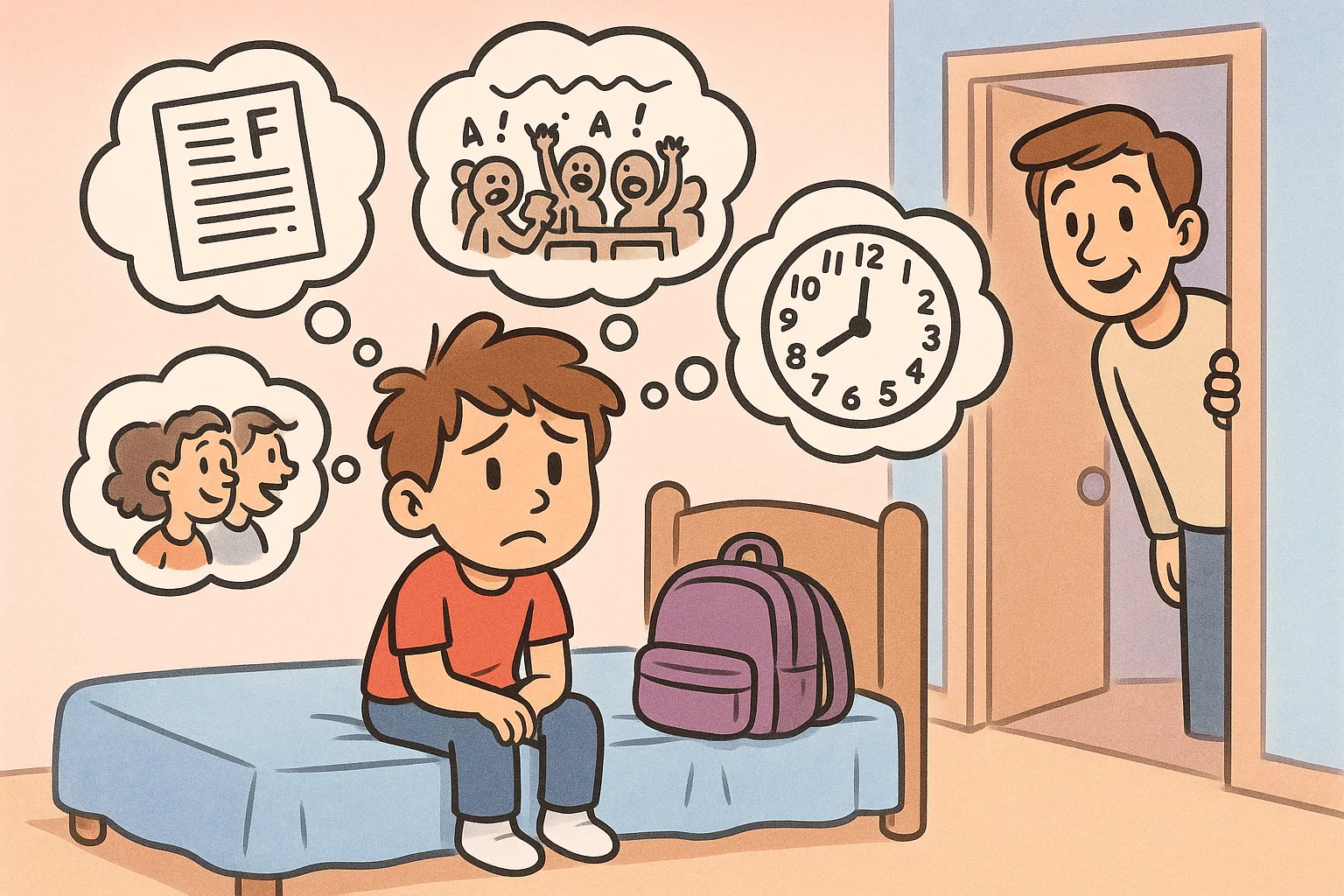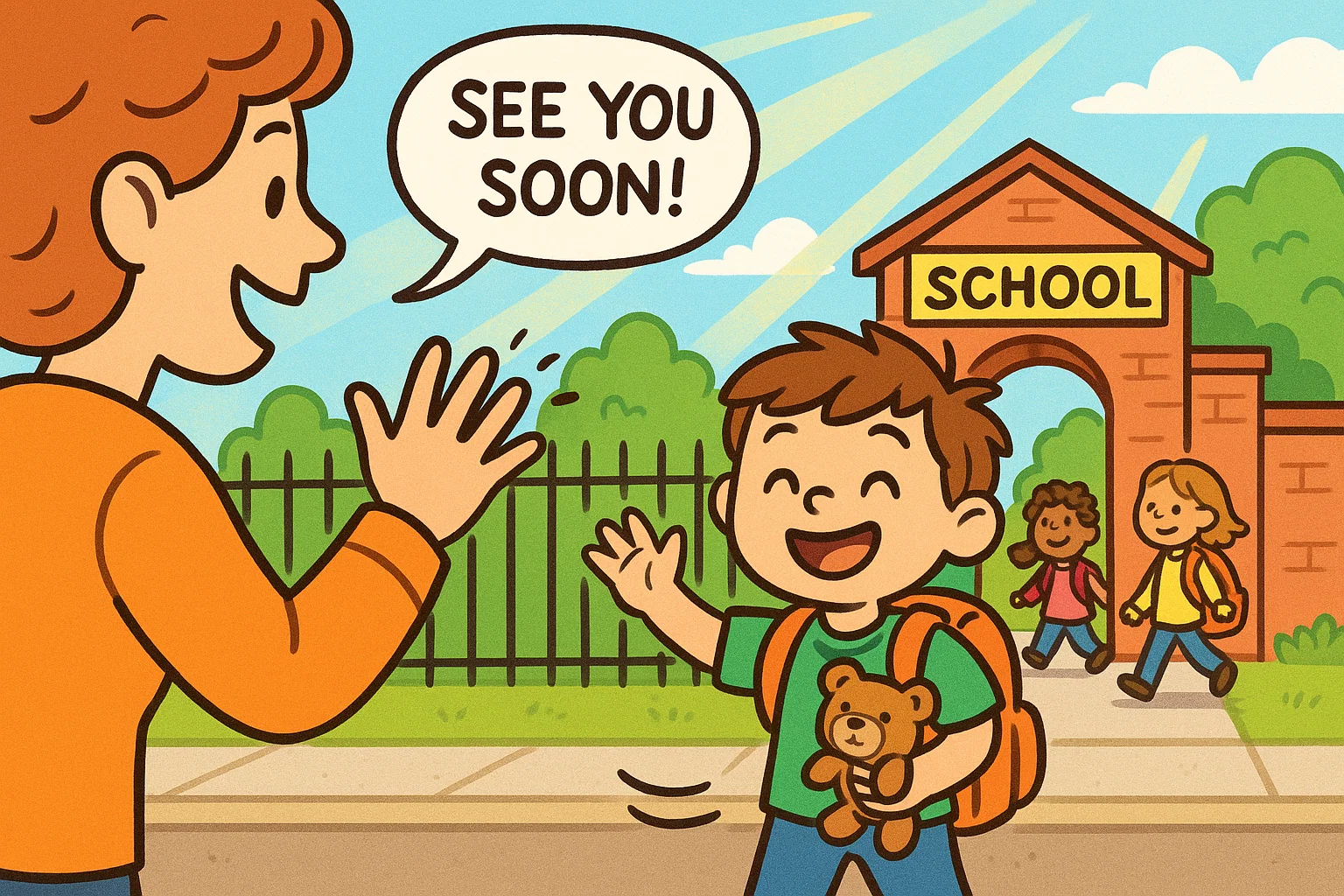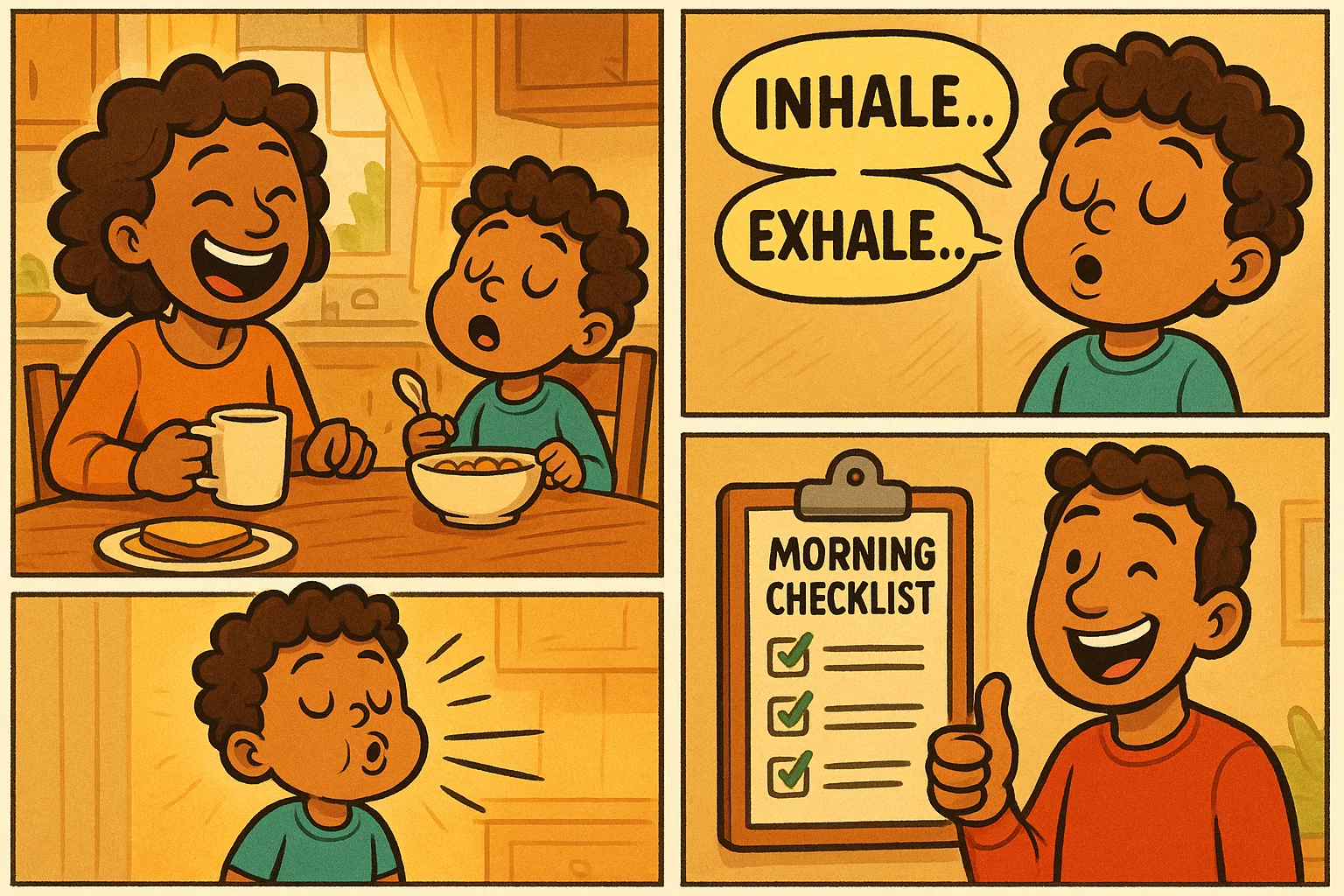How to Calm Kids Before School And Reduce School Anxiety

The morning rush is a common source of stress and anxiety in many households. For children, the transition from the comfort of home to the structure of the school day can feel like an abrupt shock, often leading to tears, tantrums, or outright school refusal. This emotional overwhelm isn’t just about being tired; it’s often a mix of sensory overload, the pressure of a tight school routine, and underlying anxiety about school. Understanding this challenge is the first step in creating a calmer start to the day.
As a parent or carer, you want to help your child feel safe and ready. This guide provides practical advice and actionable strategies to ease back-to-school anxiety and the daily morning emotional load. We will explore the root causes of their distress, offer proven techniques to establish a peaceful school routine, and equip you with communication tools to support your child effectively. Our goal is to empower you to help your child manage their feelings of anxiety so they can approach the new school year—or any school day—with confidence.
Why Kids Get Upset or Anxious Before School

It’s entirely normal for children to feel a degree of nervousness when going to school, especially at the start of a new school year or when starting a new school. However, when these worries manifest as persistent distress, it signals a need for more support. The triggers for this stress and anxiety are varied and often overlap.
- Separation Anxiety: This is particularly common in younger children who may struggle when separating from parents and carers at the school gate or classroom door. It stems from a fear that something bad might happen while they are apart.
- Academic Pressure: Older children and teenagers often feel anxious about school due to the fear of failure, difficult tests, heavy workloads, or concerns about keeping up with peers. This can make the upcoming school year feel overwhelming.
- Fear of Social Situations: Worries about fitting in, making friends, bullying, or having to navigate complex social dynamics are significant stressors. A child may fear the playground as much as the classroom.
- Sensory Overload: For some children and young people, the school environment—the noise of the cafeteria, the bright lights, the crowded hallways—can be physically and emotionally overwhelming, leading to morning resistance.
Common Emotional and Physical Signs of Stress
Children’s anxiety often shows up as physical or behavioral issues, making it crucial for parents to spot the signs of anxiety.
| Category | Signs of Stress and Anxiety in Children |
| Physical Symptoms | Recurrent stomach aches, headaches, nausea (especially on school day mornings), fatigue, changes in appetite or sleep. |
| Emotional Cues | Increased irritability, unexplained tears, unusual clinginess, frequent reassurance-seeking, anger outbursts, mood swings. |
| Behavioral Changes | School refusal or procrastination, withdrawal from family or friends, difficulty concentrating, refusal to dress or eat, regression to younger behaviors. |
It is important to differentiate between typical back-to-school jitters and more chronic back to school anxiety. Occasional morning grumpiness is normal, but persistent physical complaints that vanish once the child is away from school, or a deep, sustained reluctance to attend school, may indicate emotionally-based school avoidance (EBSA) or a more significant anxiety disorder.
Psychological Factors Behind Morning Resistance
A child’s personality and underlying mental health play a significant role in how they cope with the transition back to school.
- Attachment and Temperament: A child with a sensitive temperament or insecure attachment style may naturally experience greater separation anxiety and struggle more to manage their feelings of anxiety.
- Sleep Quality: As noted by health bodies like the NHS, poor sleep directly impacts emotional regulation. A lack of restorative sleep makes it incredibly hard for a child to feel calm and resilient in the face of stress.
- Anticipation of Difficult School Events: Sometimes, the child may be focused on a specific upcoming event—a presentation, a conflict with a friend, or a tough subject—which can drive the whole morning’s distress. Help them identify the specific aspects of school causing their anxiety.
How Environment Affects Mood Before School
The immediate home environment before departure can either soothe or intensify a child’s anxiety.
- Noise and Time Pressure: A chaotic, rushed, and loud morning overwhelms a child’s sensory system, making them less able to deal with anxiety. The feeling of being late creates a sense of panic that can trigger meltdowns.
- Lack of Routine: A predictable school routine acts as an anchor. When the schedule is erratic, the child doesn’t know what to expect, and this uncertainty fuels stress and anxiety.
To counter this, implement simple calming adjustments at home:
- Use soft, natural light instead of harsh overheads.
- Play calming, instrumental music.
- Use a timer or countdown clock to manage time visually rather than relying on parental nagging.
- Designate a “calm corner” for a quick reset if needed.
Morning Routine That Reduces Stress
A well-structured and predictable morning routine is one of the best ways to reduce anxiety and help a child transition smoothly. Predictability breeds security, which in turn helps your child feel more comfortable and in control.
Plan the Night Before
The foundation for a calm morning is laid the evening before. Investing time with your child in planning prevents frantic last-minute searches and decisions.
- Prioritize Sleep: Ensure your child gets the appropriate amount of sleep for their age. Sleep deprivation is a major contributor to mood volatility and heightened anxiety in children.
- Clothes and Bags Ready: Lay out the next day’s clothes, and pack the school bag fully. Place everything by the door, so the child’s responsibility is reduced to simply putting it on and picking it up.
- Review the Day: Have a quick, positive chat about the next day. “Tomorrow, you have art first, and then we’re having chicken for dinner. Anything you’re excited about?”
| Age Group | Recommended Sleep (Source: NHS/AAP guidelines) |
| Younger Children (3-5 years) | 10-13 hours (including naps) |
| School-Aged Children (6-12 years) | 9-12 hours |
| Teenagers (13-18 years) | 8-10 hours |
Create Calm Wake-Up Rituals
The way a child wakes up sets the tone for the rest of the morning.
- Gentle Awakening: Avoid sudden, jarring alarms. Use a calm voice, a soft hug, or a gradual light alarm clock to wake them up.
- Positive Start: Offer a genuine compliment or a simple, positive affirmation. For instance, “Good morning, sunshine! I’m so happy to start this day with you,” or “Today is going to be a good day at school.” This helps encourage your child and builds confidence.
Use Visual Schedules or Routine Charts
Visual aids are incredibly powerful, especially for younger children or those struggling with anxiety or attention challenges. They show the plan clearly and give kids a sense of control.
- How to Use: Create a simple chart with pictures or small drawings representing each step: Wake Up, Bathroom, Get Dressed, Eat Breakfast, Brush Teeth, Go to School.
- Benefits: When a child asks, “What’s next?” you can simply point to the chart, reducing the likelihood of a power struggle and helping to reduce anxiety by making the sequence predictable.
Make Breakfast a Moment of Connection
Breakfast should be a calm, unhurried time. Eating a nutritious meal supports physical and mental readiness for the school day.
- Balanced Nutrition: Offer foods that support focus, like whole grains, protein (eggs, yogurt), and fruit. Avoid high-sugar options that can lead to energy crashes.
- Connect, Don’t Correct: Use this time for light, positive conversation, not for nagging or reviewing mistakes from the previous day. This is a crucial moment to help your child feel calm and loved before they leave.
Talking to Kids About School Anxiety

Effective communication is the cornerstone of helping a child manage their anxiety. They need to feel heard and understood before they can even begin to cope.
Start the Conversation Without Pressure
Find a neutral, relaxed time to talk to your child, perhaps while driving or during a quiet evening activity. Avoid the pressured rush of the morning.
- Use Empathy: Open the discussion gently. “I’ve noticed you seem quiet lately, or maybe a little bit worried when it’s time to go back to school. Is there anything on your mind?”
- “I” Statements: Frame your concerns around your observations, not accusations: “I see you rubbing your tummy a lot on Monday mornings. That makes me wonder if you are feeling anxious about school.”
Normalize Feelings and Offer Reassurance
The goal is validation, not immediate problem-solving. Many children experience this, and knowing they aren’t alone is a powerful comfort.
“It’s completely okay to feel nervous about starting school or the going back to school routine. Lots of kids, even grown-ups, feel that way when they have a big change. We all feel worried sometimes, and that’s just our body trying to protect us.”
- Listen Actively: Nod, maintain eye contact, and avoid interrupting. Ask open-ended questions like, “Help them identify what exactly is making them anxious.” Is it the loudness? The teacher? The walk to school?
Use Storytelling or Play to Explore Emotions
For younger children or those who struggle to verbalize, indirect methods are often more effective.
- Play It Out at Home: Use puppets, stuffed animals, or Lego figures to act out a school day. “Oh no, Teddy is worried about the math test. What does he need to do to feel brave?”
- Drawing Worries: Ask your child to draw their worry monster or the thing that makes them feel anxious. Once it’s externalized, you can brainstorm strategies to help manage the “monster.”
Encourage Self-Expression and Positive Thinking
Building internal resilience is a long-term strategy to help reduce the severity of stress.
- Journaling/Drawing: Encourage older children to keep a worry journal where they can write or draw their thoughts. This prevents worries from swirling uncontrollably in their mind.
- Morning Reflections: Before leaving, ask for one thing they are genuinely looking forward to. This shifts the focus from dread to anticipation.
Calming Techniques Before Leaving Home
These practical, evidence-based techniques can be taught to help children physically interrupt their stress response and help them feel less overwhelmed.
Simple Breathing or Relaxation Exercises
Breathing is the fastest way to help calm the nervous system.
- “Smell the Flower, Blow the Candle”: Have your child take a slow, deep breath in through the nose (smelling a pretend flower) and a long, slow exhale out through the mouth (blowing out a pretend candle). Repeat five times.
- “Belly Breathing”: Lie down or sit up straight. Put a small toy on their belly and have them watch it rise and fall with their breath. This helps their breathing slow down and relax.
Sensory and Physical Soothing Strategies
Sensory input can be grounding for a child struggling with anxiety or overstimulation.
- Heavy Work: Physical activity that involves resistance can be incredibly regulating. This includes carrying a heavy backpack, pushing a laundry basket across the floor, or giving themselves a very tight, firm hug.
- Fidget Tools: A simple fidget toy, stress ball, or piece of silly putty can provide a safe outlet for nervous energy. Make sure your child knows these are calming tools, not toys for distraction.
Short Music or Movement Breaks
Before the intense focus of getting out the door, a brief moment of structured fun can release tension.
- Calm Movement: Put on a favorite, cheerful (but not overstimulating) song and dance together for 2-3 minutes. This releases endorphins and shifts the mood.
- Stretching: Gentle stretching or child’s yoga poses can release tension held in the neck, shoulders, and back, which is common when a child is worried about school.
Using Routine Phrases or Mantras
Mantras are short, positive statements that children can repeat to themselves to build self-efficacy.
Examples:
- “I am safe, I am ready.”
- “I can handle this school day.”
- “We can do this. Let’s start our day with calm energy.”
- “My feelings are big, but I am bigger.”
Preparing Kids for Transitions and School Drop-Off

The final stage—the journey to the child’s school and the goodbye—is often the most fraught. Strategic drop-offs are key to reducing separation anxiety.
Practice the Route and Routine Together
If a child is starting a new school or starting school for the first time, familiarity is a huge stress reliever.
- School Before the First Day: If possible, arrange a tour of the school or walk the path to the front school gate. Familiar faces and places help them feel less nervous.
- Practice the Goodbye Routine: Practice a quick goodbye sequence at home: a hug, a wave, and a positive statement. This gives the child a sense of control over the actual event.
Keep Goodbyes Short but Warm
Prolonged goodbyes are one of the mistakes parents often make; they inadvertently signal that the separation is dangerous or difficult, which increases the child’s distress.
- The Confidence Rule: Maintain a confident, cheerful, and matter-of-fact tone. Your calmness will help calm your child.
- Consistency: Use a consistent, brief phrase (“I love you, have a great day, I’ll see you later!”). Say it, hug them, and leave promptly. Don’t linger or extend the goodbye.
Build a Positive Association with School
Shift the focus from what they’re missing at home to what they’re gaining at school.
- Talk about the fun thing they’ll do today: “You get to play with your friend Ben at recess!” or “I wonder what cool experiment you’ll do in science today.”
- Frame the day as a bridge to a pleasant reunion: “When you get home, we can read that new book together.”
Use Transitional Objects
A transitional object provides a concrete link between home and school, acting as a security blanket for feelings of anxiety.
- Examples: A small, authorized fidget tool, a tiny photo of the family in their backpack pocket, a special bracelet, or a simple handwritten note from a parent. This object should be small and unobtrusive, to help them feel close to you throughout the school day.
When School Anxiety Persists
While these tips to help are effective for mild jitters, sometimes a child struggling with school is a deeper issue requiring professional input.
Signs It’s More Than Morning Stress
If a child’s anxiety is severe, it may manifest as more persistent and debilitating symptoms.
- Chronic Physical Symptoms: The child repeatedly reports feeling unwell, and the symptoms (stomach pain, headaches) prevent them from attending school day after day, despite medical clearance.
- School Refusal/Avoidance: The child consistently refuses to go to school, leading to extended time away from school. This pattern lasts for several weeks.
- Emotional Escalation: Crying spells, panic attacks, or extreme distress escalate as the day progresses, persisting long after the morning drop-off.
- Impact on Life: The anxiety is impacting family life, social relationships, and the child’s development.
Cooperating with Teachers and School Staff
The school is a crucial partner in getting your child the support they need to successfully attend school.
- Share Observations: Communicate the specific signs of anxiety you are seeing at home.
- Request a Meeting: Ask to meet with the teacher, school counselor, or head of year to discuss a joint strategy. The school can help by providing small accommodations (e.g., meeting the child at the school gate, a pre-arranged time-out spot).
- Gradual Reintegration Plan: Work together on a plan, often a gradual return to school schedule, if the child has been away from school.
Seeking Professional Support
If you’ve tried all the home strategies and the child’s anxiety is still severely impacting their attendance, it’s time to seek expert help.
- Child Psychologist or Therapist: They can diagnose anxiety disorders, identify the underlying causes (which many children cannot articulate), and teach the child effective cognitive behavioral therapy (CBT) skills to manage their anxiety.
- School Counselor/Social Worker: They are experts in school-based interventions and can often provide short-term, in-school counseling.
- Pediatrician/GP: Your doctor can rule out any physical causes for stomach pain or headaches and can also refer your child to local mental health services, such as those provided by the NHS in the UK.
Supporting Kids During Transition Back After Absence
When a child has had a long period away from school due to anxiety, the return must be slow and supported.
- Gradual Exposure: The child may start with just one or two classes, or just mornings, gradually increasing their school day length.
- Designated Contact: Ensure the child has one specific, trusted adult at school who can help them if they feel overwhelmed.
- Focus on Success: Celebrate small wins! Acknowledging that they made it through a short period is more important than pressuring them to stay a full day immediately.
Real Parent Experiences and Practical Tips

Learning from others who have successfully navigated this can be incredibly validating for parents and carers.
Morning Wins: What Worked for Other Parents
- “My seven-year-old was struggling with school drop-offs. We started letting him choose the one song we play in the car every morning. It’s a small thing, but that moment of control is enough to help them feel calmer by the time we arrive.” (Parent of a Year 3 student)
- “We implemented a ‘Three-Minute Power Hug.’ Before the school day starts, we stop everything and hold a tight, firm hug for a full three minutes. It calms both of us down and acts as our definitive goodbye.” (Carer of a child experiencing separation anxiety)
- “For my teen struggling with anxiety, the simple visual schedule felt too young for her. We switched to a shared online checklist on a family app. She ticks off ‘Backpack Packed,’ ‘Check Homework,’ and ‘Eat Breakfast.’ It helps her feel independent and organized.” (Parent of a 15-year-old)
Mistakes Parents Often Make
While we all mean well, some common reactions unintentionally make anxiety around school worse.
- Dismissing Feelings: Saying things like “There’s nothing to worry about” or “Just be brave” dismisses the child’s internal experience. Instead, help them feel heard: “That worry feels very real to you right now.”
- Punishment: Punishing a child for crying or refusing to go to school is never effective. Anxiety is not a choice; it’s a physiological response. Punishment only adds shame and makes the child feel less likely to seek help.
- Rushing and Panicking: Your stress is contagious. If you are frantic, it validates the child’s belief that there is something to panic about. Parents can help by modeling calm behavior, even when things are running late.
Creating a Calm Family Mindset
One of the ways to help a child is to take care of yourself. You cannot pour from an empty cup.
- Parental Self-Care: Take your own few minutes of quiet time or use the breathing techniques. Modeling emotional regulation is one of the most powerful ways to support your child.
- Family Values: Emphasize that your family values effort, kindness, and resilience more than perfection or grades. This reduces the primary source of stress and anxiety for older children.
Useful Resources and Support Lines
You don’t have to navigate back to school anxiety alone. Professional and community support are available.
National Helplines and Support Services
These resources are designed to offer immediate, confidential advice to parents and carers on how to help your child.
- YoungMinds Parents Helpline: Provides free, confidential advice to help if you’re worried about your child’s behavior or mental health. They can help you work through a plan.
- NSPCC: Offers support and information for children and adults concerned about a child’s safety or emotional well-being.
- NHS 111 (UK): For urgent but non-life-threatening mental health concerns, they can direct you to the appropriate local crisis team or service.
Recommended Reading and Online Programs
- Books for Parents: Look for titles that explain CBT techniques in a child-friendly way, such as What to Do When You Worry Too Much (a workbook for kids) or parenting books on temperament.
- Mindfulness Apps: Apps like Calm or Headspace offer kid-friendly guided meditations and breathing exercises to help calm and manage their anxiety.
- Online Programs: Many reputable child development centers offer online guides and workshops for help parents understand and address anxiety in children.
School and Community Support
Remember that the school can also be a resource.
- School Counselor/Social Worker: A key point of contact for in-school support.
- Local Support Groups: Search for local parenting groups or anxiety support organizations. Hearing the experiences of other parents and carers whose children are struggling with anxiety can reduce isolation and provide practical solutions.
